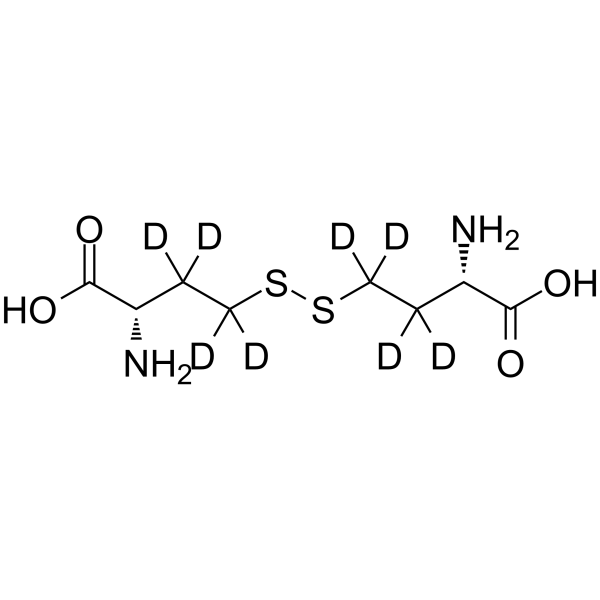L-Homocystine-d8
Modify Date: 2024-01-17 12:01:12

L-Homocystine-d8 structure
|
Common Name | L-Homocystine-d8 | ||
|---|---|---|---|---|
| CAS Number | 182755-41-5 | Molecular Weight | 276.40 | |
| Density | 1.4±0.1 g/cm3 | Boiling Point | 507.6±50.0 °C at 760 mmHg | |
| Molecular Formula | C8H8D8N2O4S2 | Melting Point | N/A | |
| MSDS | N/A | Flash Point | 260.8±30.1 °C | |
Use of L-Homocystine-d8L-Homocystine-d8 is the deuterium labeled L-Homocystine. L-Homocystine is the oxidized member of the L-homocysteine. Homocysteine is a pro-thrombotic factor, vasodilation impairing agent, pro-inflammatory factor and endoplasmatic reticulum-stress inducer used to study cardiovascular disease mechanisms. |
| Name | (2S)-2-(2H2)Amino-4-{[3-amino-3-carboxy(1-2H1)propyl]disulfanyl}(2H5)butanoic acid |
|---|---|
| Synonym | More Synonyms |
| Description | L-Homocystine-d8 is the deuterium labeled L-Homocystine. L-Homocystine is the oxidized member of the L-homocysteine. Homocysteine is a pro-thrombotic factor, vasodilation impairing agent, pro-inflammatory factor and endoplasmatic reticulum-stress inducer used to study cardiovascular disease mechanisms. |
|---|---|
| In Vitro | Stable heavy isotopes of hydrogen, carbon, and other elements have been incorporated into drug molecules, largely as tracers for quantitation during the drug development process. Deuteration has gained attention because of its potential to affect the pharmacokinetic and metabolic profiles of drugs[1]. |
| References |
| Density | 1.4±0.1 g/cm3 |
|---|---|
| Boiling Point | 507.6±50.0 °C at 760 mmHg |
| Molecular Formula | C8H8D8N2O4S2 |
| Molecular Weight | 276.40 |
| Flash Point | 260.8±30.1 °C |
| Exact Mass | 276.105347 |
| LogP | 1.03 |
| Vapour Pressure | 0.0±2.8 mmHg at 25°C |
| Index of Refraction | 1.619 |
| (2S)-2-(H)Amino-4-{[3-amino-3-carboxy(1-H)propyl]disulfanyl}(H)butanoic acid |
| Butanoic-2,3,3,4,4-d acid, 2-(amino-d)-4-[(3-amino-3-carboxypropyl-1-d)dithio]-, (2S)- |